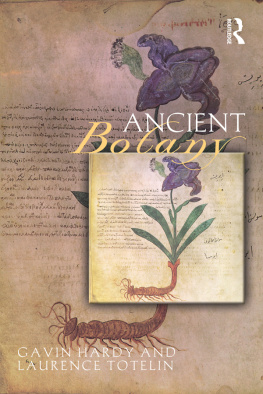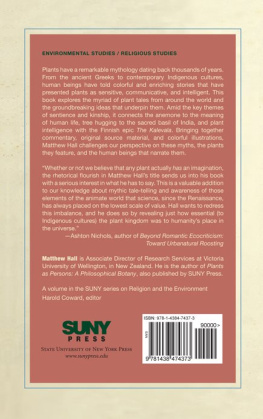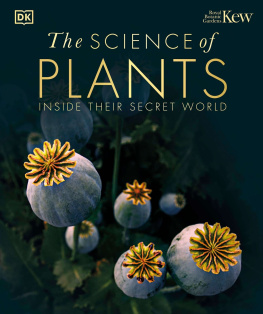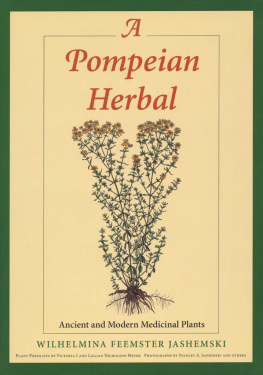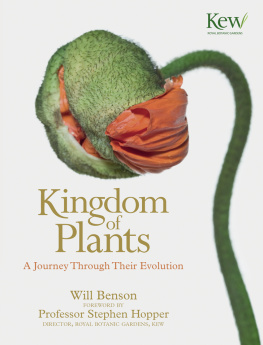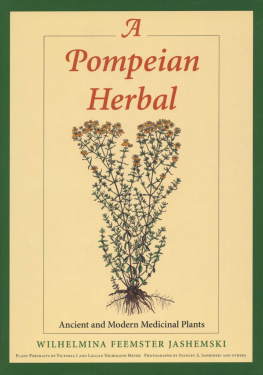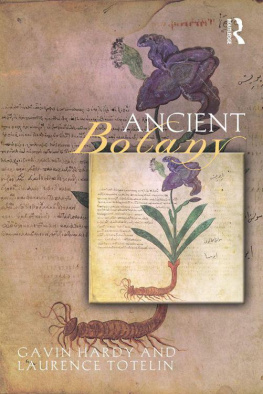Hardy F. G. - Ancient Botany
Here you can read online Hardy F. G. - Ancient Botany full text of the book (entire story) in english for free. Download pdf and epub, get meaning, cover and reviews about this ebook. City: London;New York;Greece;Rome (Empire, year: 2016, publisher: Taylor & Francis (CAM);Routledge, genre: Art. Description of the work, (preface) as well as reviews are available. Best literature library LitArk.com created for fans of good reading and offers a wide selection of genres:
Romance novel
Science fiction
Adventure
Detective
Science
History
Home and family
Prose
Art
Politics
Computer
Non-fiction
Religion
Business
Children
Humor
Choose a favorite category and find really read worthwhile books. Enjoy immersion in the world of imagination, feel the emotions of the characters or learn something new for yourself, make an fascinating discovery.
- Book:Ancient Botany
- Author:
- Publisher:Taylor & Francis (CAM);Routledge
- Genre:
- Year:2016
- City:London;New York;Greece;Rome (Empire
- Rating:3 / 5
- Favourites:Add to favourites
- Your mark:
- 60
- 1
- 2
- 3
- 4
- 5
Ancient Botany: summary, description and annotation
We offer to read an annotation, description, summary or preface (depends on what the author of the book "Ancient Botany" wrote himself). If you haven't found the necessary information about the book — write in the comments, we will try to find it.
Ancient Botany — read online for free the complete book (whole text) full work
Below is the text of the book, divided by pages. System saving the place of the last page read, allows you to conveniently read the book "Ancient Botany" online for free, without having to search again every time where you left off. Put a bookmark, and you can go to the page where you finished reading at any time.
Font size:
Interval:
Bookmark:
First published 2016
by Routledge
2 Park Square, Milton Park, Abingdon, Oxon OX14 4RN
and by Routledge
711 Third Avenue, New York, NY 10017
Routledge is an imprint of the Taylor & Francis Group, an informa business
2016 Gavin Hardy and Laurence Totelin
The right of gavin Hardy and Laurence Totelin to be identified as authors of this work has been asserted by them in accordance with sections 77 and 78 of the Copyright, Designs and Patents Act 1988.
All rights reserved. No part of this book may be reprinted or reproduced or utilised in any form or by any electronic, mechanical, or other means, now known or hereafter invented, including photocopying and recording, or in any information storage or retrieval system, without permission in writing from the publishers.
Trademark notice: Product or corporate names may be trademarks or registered trademarks, and are used only for identification and explanation without intent to infringe.
British Library Cataloguing-in-Publication Data
A catalogue record for this book is available from the British Library
Library of Congress Cataloging- in-Publication Data
Hardy, F. G.
Ancient botany / Gavin Hardy and Laurence M.V. Totelin.
pages cm. (Sciences of antiquity)
Includes bibliographical references and indexes.
1. Botany, MedicalGreeceHistory. 2. Botany, MedicalRomeHistory. 3. BotanyGreeceHistory.
4. BotanyRomeHistory. 5. Materia medica, Vegetable. 6. Medicine, Greek and Roman. I. Totelin,
Laurence M. V. II. Title.
RS63.H37 2015
615.10945632dc23
2015012293
ISBN 978-0-415-31119-9 (hbk)
ISBN 978-0-415-31120-5 (pbk)
ISBN 978-0-203-45835-8 (ebk)
Typeset in Times New Roman
by Wearset Ltd, Boldon, Tyne and Wear

This book will, we hope, appeal both to students of ancient Greek and Roman societies and to modern botanists with an interest in the history of their discipline. Conventions that are familiar to one group of readers may not be to the other, and for this reason we have chosen to spell things out here.
We have limited our use of endnotes to a minimum, opting instead for in-text references. We have used endnotes when we felt in-text references would hinder the flow of reading, or to add suggestions for further reading.
We use the abbreviations BCE and CE to refer, respectively, to before the Common Era and of the Common Era. When obvious, we have omitted CE .
A large number of ancient authors are mentioned in this book. Whenever possible, we have added dates and some biographical information. The reader will find more information on these ancient authors in The Encyclopedia of Ancient Natural Scientists: The Greek Tradition and its Many Heirs , edited by Paul T. Keyser and Georgia L. Irby-Massie (2008), to which we refer extensively.
The texts discussed in this book were written, for the most part, in ancient Greek and in Latin. Unless stated otherwise, all translations from the Greek and Latin were produced by Laurence Totelin. Within translations, square brackets are used to supplement words in English that are not found in the Greek or Latin text. Important Greek and Latin words are given in round brackets. Both Greek and Latin are languages with declensions. This means that the same noun or adjective has different endings according to its case (its grammatical function). When we give a Greek or Latin word within brackets in our translation, we give it in its original grammatical form.
We transliterate Greek terms, that is, we render them in the Latin alphabet. There are various systems of transliterations, all imperfect. Here, the letters eta and omega are rendered respectively as and . The letter upsilon is rendered as u. The letters kappa and chi are rendered as k and ch. The rough breathing at the beginning of words is rendered by the letter h. Accents are not rendered, even though ancient Greek is an accentuated language. All Greek personal names are Latinised. That is, we chose to talk about Theophrastus rather than Theophrastos.
We refer to ancient texts using an English title, and limiting our use of abbreviations to the strictest minimum, as this is probably the most confusing aspect of classical studies to the non-specialist. However, since it is customary among classicists to refer to both ancient Greek and Latin texts using Latin titles, we have mentioned these in bracket at the first occurrence of a text. For a handful of titles, we use a transliterated form of the Greek title: Alexipharmaka ; Theriaka ; and Geoponika .
It is conventional to refer to an ancient text by giving a book, chapter, and in some cases, paragraph within a chapter, as in the following example: Theophrastus, Enquiry into Plants 2.1.3, where 2 refers to book two, 1 to *******chapter one, and 3 to the paragraph. For other texts, additional conventions are used. Thus, it is conventional to refer to a passage in the works of Aristotle by giving a book number, a paragraph number and the Bekker number (in reference to the authoritative nineteenth-century edition of Immanuel Bekker), which consist in a number (a page number), the letter a or b (referring to a column), and a number between 1 and 35 (referring to a line number). For instance, Aristotle, Generation of Animals 1.18, 726a7, where 1 refers to the book number; 18 to the chapter number; 726 to the page in Bekkers edition; a to column a in Bekkers edition; and 7 to the line in Bekkers edition. Bekker numbers are printed in the margins of all modern editions of Aristotle. In the case of texts by Plato and Plutarch, it is conventional to give the Stephanus number, that is, a page number and page section (ad) in the sixteenth-century edition by Henri Estienne. For instance, we refer to Plato, Timaeus 77a, where 77 is the page in Etiennes edition, and a is the section of that page in Etiennes edition.
In the case of Greek and Latin medical texts, which are famously difficult to navigate, it is conventional to give a reference to one or several modern editions. This can be done in a number of ways. Here we have opted for the following. In the case of works from the Hippocratic Corpus, we have given a reference to the edition in the Loeb Classical Library (when available) and to the nineteenth-century edition by mile Littr (18391861). For instance, in the reference Hippocratic Corpus, Nature of the Child 22, Loeb 10.60 Potter = 7.514 Littr, Loeb 10 refers to volume 10 in the edition of the Hippocratic Corpus in the Loeb Classical Library; 60 refers to the page in that edition; and Potter refers to Paul Potter, the editor of that text; 7 refers to the volume in Littrs edition; and 514 refers to the page in Littrs edition. In the case of works attributed to Galen, we have given a reference to the nineteenth-century edition by Karl Gottlob Khn (18211833). For instance, in the reference Galen, Properties of Foodstuffs 1.37, 6.552 Khn, 6 refers to the volume in Khns edition, and 552 to the page in Khns edition. For the works of Oribasius, Aetius and Paul of Aegina, we have given references to the Corpus Medicorum Graecorum editions. For instance, in the reference Oribasius, Medical Collection 11.1.1, CMG 6.1.2, p. 80 Raeder, CMG 6.1.2 refers to the number given to this edition in the Corpus Medicorum Graecorum , Raeder is the name of the editor of this text, and p. 80 is the page number in this volume of the CMG.
As the number of papyri mentioned in this book is relatively limited, we have referred to these in abbreviated form, as is conventional among classicists. All abbreviations are given in the list of abbreviations on p. xiv. When available, we have also given the Trismegistos number of the papyrus. Trismegistos is an online catalogue of papyri and inscriptions (www.trismegistos.org, accessed March 2015). In the case of literary papyri, and when available, we have also given the CeDoPal number of the papyrus. CeDoPal is an online catalogue of literary papyrus developed at the Universit de Lige (Belgium) (http://web.philo.ulg.ac.be/cedopal, accessed March 2015).
Font size:
Interval:
Bookmark:
Similar books «Ancient Botany»
Look at similar books to Ancient Botany. We have selected literature similar in name and meaning in the hope of providing readers with more options to find new, interesting, not yet read works.
Discussion, reviews of the book Ancient Botany and just readers' own opinions. Leave your comments, write what you think about the work, its meaning or the main characters. Specify what exactly you liked and what you didn't like, and why you think so.

